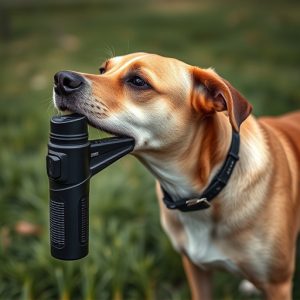Canine Pepper Spray: Effectiveness, Safety, and Legal Considerations with OC Percentage
The OC Percentage in Canine Pepper Spray is a balancing act between potency and safety. Formulated w…….
The OC Percentage in Canine Pepper Spray is a balancing act between potency and safety. Formulated with capsaicin, typically 5% to 10% OC, these sprays temporarily disable dogs without severe harm. Higher OC levels offer more protection but require careful handling. Owners should select products with expert-recommended percentages for effectiveness while minimizing health risks. Proper application techniques, like targeting eyes and faces at close range, combined with safety precautions like protective gear and ventilation, ensure responsible use. Ethical deployment, as a last resort after other deterrents fail, adheres to legal guidelines and minimizes harm or stress to dogs, with the OC percentage playing a crucial role.
“In today’s evolving world, safeguarding ourselves and our loved ones is paramount. One often-overlooked tool in personal protection is canine pepper spray, designed for dogs trained in security and defense. This article delves into ‘Understanding Canine Pepper Spray: A Comprehensive Overview,’ exploring the science behind it. We dissect the crucial role of OC (Oleoresin Capsicum) percentage in its effectiveness. Additionally, we weigh the benefits, considerations, application techniques, safety precautions, and legal implications surrounding this game-changer. By the end, readers will grasp why the OC Percentage in canine pepper spray is a key factor for optimal results.”
- Understanding Canine Pepper Spray: A Comprehensive Overview
- The Role of OC Percentage in Dog Pepper Spray Effectiveness
- Benefits and Considerations for Using Pepper Spray on Protection Dogs
- Application Techniques and Safety Precautions for Optimal Results
- Legal Implications and Ethical Use of Canine Pepper Spray
Understanding Canine Pepper Spray: A Comprehensive Overview
Canine pepper spray, a specialized protective tool, has gained significant attention as a means to ensure the safety of both dogs and their owners during jogging sessions or other outdoor activities. Unlike traditional pepper spray designed for human use, this product is formulated specifically to cause temporary disorientation and immobilization in dogs without causing serious harm. The key active ingredient is capsaicin, the compound responsible for the heat sensation in chili peppers, which is typically presented at a specific OC (Oleoresin Capsaicin) percentage.
The OC Percentage in canine pepper spray refers to the concentration of capsaicin, measured in parts per million (ppm). Higher OC percentages usually indicate a more potent effect, but it’s crucial to find a balance—a concentration that is powerful enough to deter aggressive or dangerous dogs but safe for both the dog and the user. A responsible owner should choose a spray with an OC percentage recommended by experts, typically ranging from 5% to 10%, ensuring its effectiveness while minimizing potential side effects on their pet’s health.
The Role of OC Percentage in Dog Pepper Spray Effectiveness
The effectiveness of dog pepper spray is closely tied to its Oleoresin Capsaicin (OC) percentage, a measure of the capsaicin content. OC is the active ingredient responsible for the spicy sensation and subsequent irritation that makes pepper spray a deterrent. A higher OC percentage generally translates to a more potent spray, offering better protection against potential threats. This is particularly important when considering the unique physical and behavioral traits of dogs; their size, sensory acuity, and tendency to charge or bite can make them more susceptible to certain types of deterrents.
When comparing different dog pepper sprays, understanding the OC percentage is key. A higher concentration can mean a longer-lasting effect, increased visibility during use, and a stronger physical response from the target. However, it’s crucial to balance this with safety considerations, as very high concentrations may pose additional risks, especially if the spray comes into contact with sensitive areas or is inadvertently inhaled. Therefore, pet owners should opt for products with OC levels suitable for canine use, ensuring both effectiveness and responsible application.
Benefits and Considerations for Using Pepper Spray on Protection Dogs
Application Techniques and Safety Precautions for Optimal Results
Application Techniques and Safety Precautions
When using canine pepper spray, understanding application techniques is key to achieving optimal results. Aim for the eyes and face as these areas are highly sensitive. The spray should be directed at close range, typically within 2–3 feet (0.6–0.9 meters), to ensure maximum effectiveness. The OC (Oleoresin Capsicum) percentage in the spray plays a significant role; higher concentrations (e.g., 2% or more) provide stronger irritation and immobilization but require precise application to avoid off-target effects. Practice makes perfect, so training with a non-active version before deploying the real spray is highly recommended.
Safety precautions are paramount during use. Wear protective gear, including gloves and eye protection, to minimize exposure to the spray yourself. Ensure the area is well-ventilated to prevent the accumulation of occluded gases. Keep the spray can out of reach of children and pets. In case of accidental discharge or contact with skin or eyes, have a decontaminant solution ready. Regularly inspect the spray for any signs of damage or leakage, and store it in a cool, dry place. Responsible use, combined with proper training, ensures both the effectiveness of the pepper spray and the safety of all involved.
Legal Implications and Ethical Use of Canine Pepper Spray
The ethical and legal use of canine pepper spray, also known as dog pepper spray or capsaicin spray for dogs, is a complex issue. While it offers a non-lethal option for deterring aggressive canines, its application must be strictly regulated to avoid abuse. The primary concern lies in ensuring the safety of both the dog and the person using the spray, as well as bystanders. Many countries and regions have specific laws regarding the possession, use, and distribution of pepper spray, including those formulated for dogs. These regulations often set parameters on OC (oleoresin capsicum) percentage, which is the active ingredient responsible for the burning sensation and temporary incapacitation.
Ethical considerations involve balancing public safety with animal welfare. Canine pepper spray should be employed as a last resort when other methods of deterrence have failed, and it must be used responsibly to prevent unnecessary harm or stress to the dog. The OC percentage in canine pepper spray plays a significant role in this regard, as higher concentrations can lead to longer-lasting effects and potential health complications for the animal. Thus, understanding and adhering to legal guidelines, along with exercising sound judgment, are crucial when considering the use of canine pepper spray.
The use of canine pepper spray, especially those with a specific OC (Oleoresin Capsicum) percentage, offers a powerful tool for protection dogs. As highlighted in this article, understanding the role of OC in effectiveness and knowing the legal implications are paramount. When used responsibly and with proper safety precautions, pepper spray can enhance a dog’s protective abilities without causing long-term harm. Always consider training and alternative methods first, but be prepared to empower your protection dog with this effective deterrent when necessary.


